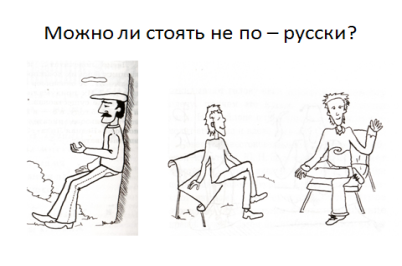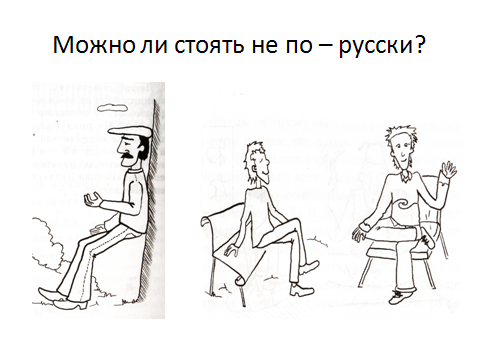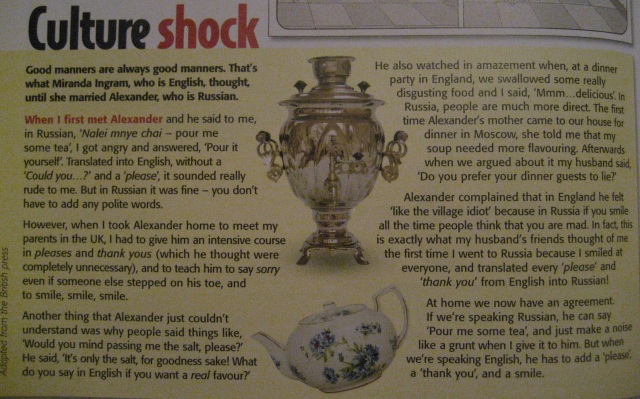- Учителю
- Конспект занятия Teaching tolerance элективного курса На перекрестке культур (10-11 класс)
Конспект занятия Teaching tolerance элективного курса На перекрестке культур (10-11 класс)
Teacher: Elena Valentinovna Patrusheva
tel. 890220648323
helenapatrusheva@mail.ru
School: Gymnasium # 41, Novouralsk (МАОУ «Гимназия № 41)
Subject: Elective course "Crossing Cultures" (the programme for the course is written by the author)
Class: 11(A group of 12 students. The students have a good command of English; they have been attending elective courses in English for 2 years; they are participants of a great number of international events; the students are highly motivated to learn English and to learn about intercultural communication))
Topic: Communicative Behaviour
Objectives:
-
To develop tolerant attitude to other people's habits, traditions, rules of behavior through culture - related information.
-
To develop oral speech skills through communication strategies.
-
To develop communicative skills through content - based instructions.
-
To develop cooperative skills through goal - oriented and partner - oriented strategies.
Techniques: discussion, group discussion, information gap, simulation, problem - solving.
Equipment: teacher's presentation, students' cards
Length of time: 45 minutes
Possible difficulties: lack of time: enthusiastic students cannot stop speaking. Some space to move freely is advisable.
C. Draws the students' attention to the screen and makes
comments:
-
This is the most typical pose for Georgian people. Russian people do not stand like this. The drawing is an illustration from a book by A.A. Leontyev, a famous Russian linguist, who is an expert in Georgian culture.
C. Express their agreement/disagreement or surprise.
C. Slide 3 
D. Asks the students to imagine that they are in a park and to sit on a "bench" putting one leg on the other one.
Makes comments: a typical Russian pose.
D. Sit putting a knee of one leg across the other one.
D .
Slide 4
.
Slide 4
E. Asks:
-
How would an American sit on a "bench"?
E. Those students who know or guess sit putting an ankle of one leg on the knee of the other one.
E .
Slide 5
.
Slide 5
F.Asks:
-
Why have you chosen this pose?
F. Answering the question the students say that they have seen this in films or in real life when communicating with American people. Etc.
F .
Slide 6
.
Slide 6
G. Draws the students' attention to slide 7 and asks to make comments on the drawings they see.
G. Looking at the drawings the students say people of which nationalities sit like this.
G
![]()
![]()
 .
Slide 7
.
Slide 7
CHALLENGE AND SETTING THE GOALS (5 minutes)
A. Asks the students to finish the sentence:
-
In accordance with the way people sit we can speak about…
B. Asks
-
What do you feel when you see other people's habits which are different from yours?
C. Asks
-
How do you express your feelings?
A. Finish the sentence
-
… their nationality
-
habits and traditions
-
their lifestyle
-
Etc.
B. Possible answers (in short):
-
They surprise me.
-
I feel that I don't like them.
-
It's all the same for me.
-
I got interested.
-
Etc.
C. Possible answers (in short):
-
I keep calm
-
I smile
-
I shrug my shoulders
-
I laugh
-
I say something
-
Etc.
D. Names academician U.E. Prokhorov who holds lectures for young people in the program "ACADEMIA" in the TV channel "Culture". Prokhorov compares communicative behaviour with a kaleidoscope.
Asks :
-
Who had got a kaleidoscope in your childhood?
-
Do you remember how many mirrors there were?
-
Why do pictures in kaleidoscopes change?
D. Answers the questions about kaleidoscopes (some of them do not remember the number of mirrors in kaleidoscopes)
E. Draws the students' attention to slide 8. Asks :
-
Why does U.E. Prokhorov compare communicative behavior with a kaleidoscope?
-
What are your hypotheses?
Asks:
-
What do you need to prove your hypotheses?
Summarizing the answers says that today in the lesson we are going to prove the hypotheses to see if professor U.E. Prokhorov is right.
E. Read the information from the slide.
Suggest their hypotheses. Possible variants:
-
Communicative behavior changes as quickly as pictures in kaleidoscopes.
-
Communicative behavior depends on changes in society.
-
It is as different as pictures in kaleidoscopes are.
-
Etc.
Possible variants:
-
Some example of life situations.
-
Some more information
-
Etc.
E.Slide 8
Communicative Behavior
-
Reality
-
Knowledge of reality
-
Our speech
INTRODUCTION OF NEW INFORMATION (25 minutes)
А. Says that U.E. Prokhorov gives some very interesting examples in his lecture and asks the students to make four groups of 3 people. Each group gets a card with a very short story written on it. One student retells the story (does not tell the end). The second student asks the question for the class. The third monitors the class.
Encourages the students to express their opinions.
А. Work in groups of three people. Each group gets a card with a short story written on it. The students read their stories to themselves and then retell them for the class. But they do not tell the end. They finish their story with a question for the class. (The roles are distributed by the students themselves).
For example:
A story:
"Being in Germany I rented a house. A nice German elderly couple whose house I rented asked if I would like to have a cup of tea. I said, "I think I will". But then they asked me a question after which I said, "No, I think I won't".
The students of this group ask the class: What was the question?
The other groups think of the answer.
(The end of the story:
They asked me "How many cups?")
4 situations are to be discussed
(See Appendix 1)
А. A set of cards with situations for each group.
B. Monitors the discussion paying attention to new information about people's behavior.
B. The students make comments on the situations comparing them with Russian habits and traditions (e.g. Russian tea drinking in situation 1)
C. Asks:
-
Why do people always shift from one foot to the other when they stand in a group or in a pair?
Monitors the discussion.
C.Discuss possible variants:
-
It is easier to stand like this.
-
Perhaps they do not like each other.
-
Their feet get tired.
-
They don't like the smell.
-
Etc.
D. Says that different people have different personal communicative space. If a person's space is short he/she intrudes another person's space who in his/ her turn steps back or aside.
Asks the students to stand up and leave the classroom so that to check their own communicative space.
D. The students stand in pairs facing each other on a long distance. One student begins moving forward to his/her partner. When the partner feels that it is enough he/she asks to stop.
E. Asks:
-
What factors do personal communicative zones depend on?
Monitors the discussion.
E. Possible variants (in short):
-
It depends on sex.
-
It depends on age.
-
It depends on a social status.
-
It depends on nationalities.
-
Etc.
F. Says that anthropologist Michael Watson watching students of different nationalities defined that their communicative zones differed.
Asks the students to make up groups of 4 students in each and simulate a talk holding a distance in accordance with a nationality written on a student's card.
F. Work in groups.
Each student has got a card with a nationality written on it.
Group 1 (Arabian, French, English, American)
Group 2 (Mexican, Italian, German, Norwegian)
Group 3 (Turkish, Japanese, Indian, Pakistan)
The students stand in groups holding a certain distance and explain why they stand like this. Then they come back to the classroom.
G. Draws the students' attention to slide 9.
H. Asks: Is there any possible misunderstanding if let's say Mexican and American people are in one circle?
Monitors the discussion and encourages the students to express their opinions.
G. Looking at the slide compare their results with Michael Watson's table. Express their agreement/disagreement or surprise.
H. Possible variants:
-
Mexican people can feel offended because Americans will step back.
-
Not necessarily. It depends on a person.
-
There are a lot of Mexicans in the USA, they have got used to each other.
-
Etc.
G. Slide 9. According to Michael Watson: Nearer: Arabian, French, Mexican, Italian, Japanese and Turkish people.
Farther: English, American, German, Norwegian, Indian, Pakistan people
I. Asks:
-
How must people behave if they live in a multinational family?
I. Discuss possible rules of behavior (in short):
-
They must be patient and tolerant.
-
They must know more about other cultures.
-
They must not pay attention to silly things.
-
Etc.
J. Suggests reading the text "Culture shock" (with no end) and thinking about a possible solution to the problem. (See Appendix 2)
Monitors the students' work in pairs and groups.
Encourages the students to discuss the end of the story
J. Read the text; discuss possible variants first in pairs, then in groups of four and tell their variants to the class.
Read the end of the story and express their opinion about it.
 J
J .Slide 10 UK vs. RUSSIA
.Slide 10 UK vs. RUSSIA
FEEDBACK (10 minutes)
А. Reminds of the 3 elements of communicative behaviour and asks each group to answer one question and tell their arguments in favor of their answer:
-
After we have discussed different problems and situations what do you think can be referred to reality? (for group 1), to our knowledge of reality (for group 2), to our speech (for group 3)?
Asks an individual from each group to come up to the blackboard and write notes under the headings.
А. Answer the question using the examples from the lesson or any others. Write their notes on the blackboard.
Group 1 (possible variants)
-
Habits
-
Traditions
-
Rules
-
Routines
-
Etc.
Group 2 (possible variants)
-
Book Knowledge
-
Life experienced knowledge
-
No knowledge
-
Etc.
Group 3(possible variants)
-
Relevant to situations
-
Irrelevant
-
Emotional
-
Polite
-
Rude
-
Etc.
А. On the blackboard:
-
Reality
-
Knowledge of reality
-
Speech
Colored magnets are used to mark students' notes.
B. Comes back to students' hypotheses and asks them to make a conclusion.
В. Make a conclusion. Possible variants:
-
If any of the 3 elements change our communicative behavior also changes as pictures in kaleidoscopes.
-
If the Chinese girl had known (knowledge of reality) that Russian people do not give artificial flowers to express gratitude (reality) her communicative bahaviour would have been different.
-
If the Russian husband (from the story) hadn't been stubborn (reality) he would have always said please (speech) and the couple's communicative behaviour would have been different.
-
To provide the right communication we must be interested in other people's life, understand different cultures, try to be polite, patient and tolerant.
-
Etc.
C. Advises to watch the program ACADEMIA , asks to look for some interesting examples of foreign people's life in Russia for the next lesson.
C. Thank the teacher for the lesson.
APPENDIX 1
Situation 1
Being in Germany I rented a house. A nice German elderly couple whose house I rented asked if I would like to have a cup of tea. I said, "I think I will". But then they asked me a question after which I said, "No, I think I won't". They asked me "How many cups?"
The question for the class: "What did they ask?"
Situation 2
Once when I finished a lecture in a Chinese university a Chinese girl came up to me to express her gratitude. Seeing her with a bouquet of flowers I was astonished. In her turn she could not understand what was wrong. The flowers were artificial!
The question for the class:
What was wrong with the flowers?
Situation 3
There was an international conference in St. Petersburg last summer. A group of foreign and Russian participants from other cities were so enthusiastic that they finished their discussion late at night. Still they decided to have a night walk. Some had to walk for a very long time as they could not reach their hotels and they were sleepy next morning. Nobody had told them the drawbridges.
The question for the class:
What happened to the participants?
Situation 4
Being on a business trip in Ireland we were told to leave our hotels earlier so that not to be late for our lecture in the university because of the traffic jams. Being a disciplined person I did as I had been asked. I have never seen such traffic jams! There were few cars on the roads. Remember traffic jams in Moscow!
The question for the class:
Why has Professor E.U. Prochorov never seen such traffic jams?
APPENDIX 2 (The last paragraph is not given to the students. They are to guess the end)
 </<br>
</<br>
9